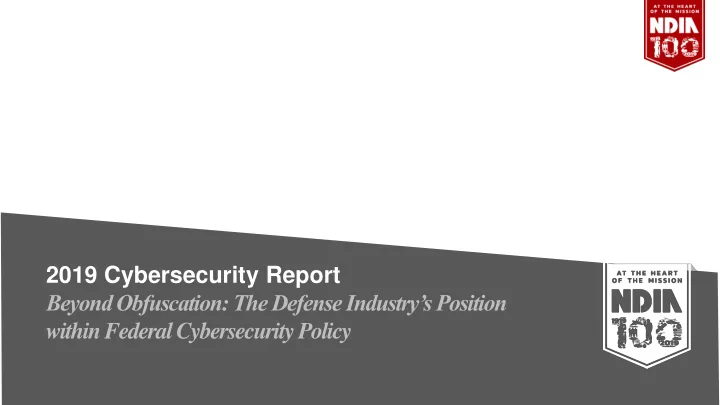

2019 Cybersecurity Report Beyond Obfuscation: The Defense Industry’s Position within Federal Cybersecurity Policy
About the Report • Section I: Illustrations of Cyber Threats and Vulnerabilities • Section II: Policy Response to Cyber Risk • Section III: Industry’s Perspective (Survey Analysis) • Section IV: Conclusions and Recommendations • Released: August 2019 • Available online at: NDIA.org/CyberStudy2019 1/9/2020 2
SECTION III: INDUSTRY’S PERSPECTIVE (SURVEY ANALYSIS) 1/9/2020 3
Methodology • Online Survey Developed with NDIA San Diego Chapter • Distributed via Email & NDIA Website • Responses Collected for 60 Days • Approximately 300 Responses Collected – Participation was not limited to NDIA members 1/9/2020 4
Demographics PRIMARY INDUSTRY Other Technology Services Manufacturing 1/9/2020 5
Demographics Number of Employees Primary Position in the Supply Chain 70% 70% 60% 60% 50% 50% 40% 40% 30% 30% 20% 20% 10% 10% 0% 0% Prime 1st tier 2nd tier 3rd tier Raw material Processor 1 to 500 501 to 1000 2001 + contractor subcontractor subcontractor subcontractor supplier 1/9/2020 6
Company Financials • Key Takeaways – Subcontractors are less dependent upon revenue from the Department of Defense than prime contractors – Small businesses have less diversified revenue streams than larger businesses 1/9/2020 7
What Security Measures Does Your Company Use? Information Uses a firewall Technology Uses two-factor or multi-factor authentication for log-ons Requires VPN usage for remote work Uses access security at the workspace in • Key Takeaways addition to door locks – Large businesses We have a dedicated in house IT person or department employ more security measures than small Has a dedicated email server businesses Relies on anti-virus software that came installed on our equipment – Small businesses are more reliant on external Hosts its own website information security We self-service but do not have staff dedicated solutions We outsource most of our IT support to an – Use of personal external provider devices is much more Other prevalent among small 0% 20% 40% 60% 80% 100% business employees Large Companies (500+ Employees) Small Companies (<500) 1/9/2020 8
Information Technology Data Storage Methods Commercial cloud service Small % Internally-owned cloud server Other-than-small % Offsite Onsite Server provided by managed-services company Internally-owned network storage An external drive Personal-use desktop or laptop only 0.0% 10.0% 20.0% 30.0% 40.0% 50.0% 60.0% 70.0% 80.0% Device Use Policy Small % Use Government-issued devices Other-than-small % Let employees use their own mobile phones, laptops or tablets for corporate purposes Issue corporate mobile phones, laptops or tablets for mobile use 0.0% 10.0% 20.0% 30.0% 40.0% 50.0% 60.0% 70.0% 80.0% 1/9/2020 9
COST ESTIMATING AND ACCOUNTING • Key Takeaways – The majority of respondents view security-related costs as a cost-driver when pricing contract bids – Industry supports treating costs associated with carrying out DFARS 7012 requirements as direct costs – Nearly half of respondents have not estimated the cost of DFARS 7012 compliance 1/9/2020 10
COST ESTIMATING AND ACCOUNTING 1/9/2020 11
Corporate Opinions • Key Takeaways – 44 percent of companies with greater than 500 employees have been the victim of a cyber attack – Of a list of potential cyber-related threats, respondents are least concerned about having a contract rescinded by a prime contractor or contracting officer as a result of a cyber incident – Small business does not have an adequate sense of the cost of responding to or recovering from a cyber incident – 44 percent of prime contractors do not have documentation of a system security plan (SSP) from their subcontractor(s) 1/9/2020 12
Corporate Opinions 1/9/2020 13
Corporate Opinions 1/9/2020 14
Corporate Opinions 1/9/2020 15
Corporate Opinions 1/9/2020 16
REPORT RECOMMENDATIONS 1/9/2020 17
Recommendations for Government • Increased communication between industry partners with a focus on small business • Right-size the flow of information to industry • Simplifying the current cyber regulatory regime 1/9/2020 18
Recommendations for Industry • Prime contractors must share best practices and experiences with lower-tier companies while working with government to manage the flow of sensitive information within the supply chain • Smaller businesses need to make a more intentional effort to adopt cyber fortifications and ensure compliance with current cyber regulations • All of industry must commit to working with government as the new CMMC program is developed to ensure that the new set of regulations is as effective as possible without an unduly burden on industry 1/9/2020 19
QUESTIONS? Corbin Evans, Director of Regulatory Policy CEVANS@NDIA.ORG (703) 247 – 2598 1/9/2020 20
Recommend
More recommend